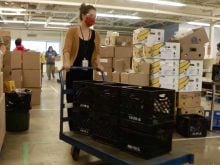Reuters / Public spending on agricultural research is on the rise, despite austerity drives in many countries, as price spikes and problems linked with climate change propel food security towards the top of government agendas, the head of a leading research body said.
“People have realized that feeding the world without destroying the environment is very likely the biggest challenge facing humanity over the next few decades,” Frank Rijsberman, chief executive of the Consortium of International Agricultural Research Centers said in a telephone interview.
The consortium, whose backers include the World Bank, the United States, Britain and the Bill and Melinda Gates Foundation, supports research targeted for the estimated 500 million smallholder farmers with less than two hectares to work.
Read Also

Manitoba Ag Days 2026: Local businesses gear up for Brandon farm show
Most of agriculture is seemingly at Manitoba Ag Days each January: Manitoba agribusinesses and farm groups look forward to connecting with farmers at the 2026 show.
Rijsberman said governments were responding to the need for a sharp increase in spending on research to boost yields with an estimated 70 per cent more food needed by 2050.
He said that to achieve needed productivity increases, the budget of the consortium, which is based in Montpellier, France, needed to rise to $1 billion by 2015 and $1.6 billion by 2020.
“We are on track to meet the $1 billion in 2015 target,” he said, adding his organization’s budget should be close to $900 million this year, up from about $700 million in 2011.
The consortium’s board allocates and prioritizes funding for research projects carried out by individual centres as well as reporting back to donors on progress.
Rijsberman said an increase in yields was vital to prevent farmers from expanding planted area through measures such as the destruction of rainforests or grasslands which can lead to more carbon emissions.
Plowing like crazy
“There is no chance of winning this battle if we don’t start off with increasing productivity, meaning improved crop varieties that are drought tolerant or resistant to new diseases like late potato blight that creeps up the mountains as climate changes,” he said.
“Right now, productivity has stayed flat and farmers are plowing under like crazy. That is a recipe for disaster for the environment,” he said.
Rijsberman said recent food price spikes had provided a “wake-up call” to governments, noting an increase in food prices in 2010-11 pushed 44 million people into poverty. For the poor, about 80 to 90 per cent of their budget goes on food.
“It will be harder to get money in that climate (austerity) but we think the warnings (price spikes) have put food security right at the top of the agenda,” he said.
Earlier this month, U.S. President Barack Obama announced a new public-private partnership program involving some $3 billion in corporate pledges, seeking to find new ways to help small-scale farmers — particularly women — who may hold the key to improved world food supplies.
“It is our job to make sure it stays on the radar,” Rijsberman said.
He said the private sector did a good job looking after large-scale farmers but added that smallholders often had “very different needs, different crops and different diseases.”
For small farmers a wide range of crops can be important as well as the big three, rice, maize and wheat, including cassava, bananas and yams.
“We are more or less the only ones working on yams, cowpeas and many other smaller crops,” he said.














